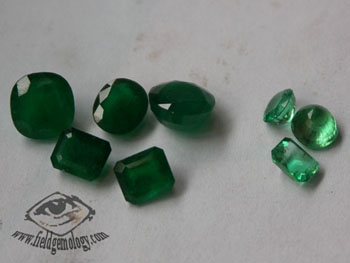People and Power
It's reckoned that as much as 60 percent of Afghanistan’s gross domestic product has been generated from the presence of foreign troops over the past decade - either directly through military spending in the country, or because of the billions of dollars of aid and investment that followed in its wake.
As recently as 2011, around 45 percent of the government's core budget - money for wages and running costs - and almost all of its funding for new projects was coming from overseas donors.
In 2013, US alone spent $12.9 in the country - $9.95bn of it on security assistance to arm and train Afghan military and police forces.
But with US and NATO forces being withdrawn by the end of this year, that flow of funds is bound to slow down and increase the strain on an economy battered by years of conflict and now uncertain about what the future holds.
Yet Afghanistan is not without its own resources.

An example of the basic difference between five emeralds from Davdar (China) and some emeralds from Panjshir (Afghanistan) from parcels seen in Namak mandi gem market in Peshawar (Pakistan).
It has vast deposits of copper (among the largest in Eurasia), iron, high-grade chrome ore, uranium, beryl, barite, lead, zinc, fluorspar, bauxite, cobalt, lithium, tantalum, emeralds, gold and silver. According to some estimates these reserves are so big and include so many minerals essential to modern industry that Afghanistan has the potential to become one of the most important mining centres in the world, worth well in excess of a trillion US dollars to the Afghani economy.
Little of this has ever been developed because of the security and political situation, but one day it might be - although exactly when, how and by whom, no one knows. For now it just sits there, waiting.
Emerald cities
One of the most intriguing examples of this huge unexploited wealth is Afghanistan's emerald industry.
There are extraordinarily rich veins of this precious green gemstone running through the Panjshir Valley and the mountains of the Hindu Kush that lie around 150 miles northeast of the capital - stones of a quality to rival the very best available from Colombia and Zambia from where most of the world’s supply currently emanates.
But though there is emerald mining in Panjshir, it is on a very small scale and almost tragically inefficient and archaic; a few thousand miners desperate to make a fortune, burrowing into peaks that are 3,000 metres high, with picks, shovels and hand-made explosives. It is slow, back breaking and dangerous work - dozens are killed every year by collapsing tunnels, rockfalls and blasting accidents - and so far it has barely made scratched at the surface.
Hamid Nazari, one of the miners who works out of a small tented encampment halfway up the mountainside, explained why they do it:
"I work 18 hours a day. I go home once a week. We have to work in very harsh conditions for a pitiful wage. But if we find emeralds, that could change our lives completely. These stones are so valuable that we accept the work. Once we earn some money, we will finally be able to send our children to school in order to educate them. And if we earn lots of money, we can start up a business. For this reason, it's very difficult to give up."
The mines, which are unlicensed by the central government in Kabul, are operated under the protection of the Massoud clan, which has long held sway over the area. It’s most famous leader, Ahmad Shah Massooud (or the Lion of Panjshir, as he’s remembered here) achieved fame across Afghanistan for his resistance to the Soviet invasion of the 1980s and then subsequently for taking the fight to the Taliban.
Assassinated by al-Qaeda in 2001, Ahmed Shah began developing the precious stones trade to finance his war effort and to buy a few million dollars' worth of arms every year. Since then things have moved on a little; emeralds from Panjshir are now sold for about $150 million a year. But almost all of the stones are smuggled out of the country uncut to Pakistan and India, yielding virtually nothing in terms of tax revenue or extra jobs if they were cut and marketed in Afghanistan before export. International gem industry experts believe that if they were managed properly, the emeralds could be worth five times as much - up to $1bn - and that is before the introduction of new mining methods and technology that could boost production drastically.
One of those most keen to see that happen is Raphael Chahboub, a former French soldier. He’s lived in Kabul since 2008. When he first arrived, Raphael was involved in training Afghan security forces, but then he stayed to venture into the emerald trade on behalf of European jewellers and dealers.
"The Afghan emerald is renowned as the best in terms of quality…one of the most crystalline, one of the purest," he explained while meeting a Panjshiri trader who had come down to Kabul to show the Frenchman a few samples. But there was a problem - the way the gems were extracted. "It leads to this," he said, holding up a glittering green splinter. "Stones that are completely smashed up."
Frustrated by the wasted potential and determined to get his hands on more exceptional stones, Raphael decided to go to Panjshir along with filmmakers Eric De Lavarène and Véronique Mauduy who went with him.
After gaining a blessing from the Massoud clan’s representatives in Kabul and dressed in local clothes to keep a low profile, he set off in a car through territory that often sees heavy Taliban activity.
"The objective of the trip is to go to the mines, meet the people who work there, forge some links, develop a network... . So you have to travel, to see what's available, and possibly find some truly magnificent samples."



